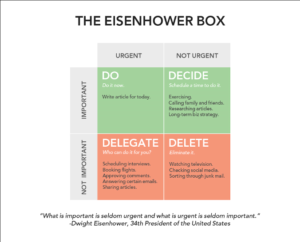Are you heading toward burnout?
July 29, 2020
 Contributed by Shawn Johal, business growth coach, leadership speaker and co-founder of DALS Lighting, Inc. He is also an active member of the Entrepreneurs’ Organization Montreal chapter.
Contributed by Shawn Johal, business growth coach, leadership speaker and co-founder of DALS Lighting, Inc. He is also an active member of the Entrepreneurs’ Organization Montreal chapter.
“If you want to find the secrets of the universe, think in terms of energy, frequency and vibration.” —Nikola Tesla
Life is busy, and focus is hard to come by. We have a plethora of responsibilities, and it’s often hard to choose where to focus our efforts. Do you ever feel overwhelmed with no idea where to start?
“Overwhelmed” is often our default mode. Many of us have simply gotten “used to” it. Instead of taking time to consider how we use our energy, we counterbalance feeling overwhelmed by going “all in”. But what if we are going 1,000 miles an hour in the wrong direction?
This tendency to go all in can quickly lead to burnout. As defined by World Psychiatry, “Burnout is a psychological syndrome emerging as a prolonged response to chronic interpersonal stressors.” It’s that emotional, physical and mental exhaustion we experience when we can’t keep up or when we’re utterly drained by going too hard.
The results of a Gallup poll bring the problem into focus: Of 7,500 full-time employees, 23 percent reported feeling burnt out at work very often or always, while an additional 44 percent reported feeling burnt out sometimes.
We all have stressors in our lives. It’s how we cope with them that matters most. Manage your energy reserves effectively and you can prevent a complete burnout and even maintain a positive mindset.
Follow these steps to help you navigate stress and protect your energy.
1. Remain aware.
Above all else, you need to know when your energy is at a near critical level. There are different types of stresses—not all of them are necessarily bad. It requires introspection and self-analysis to understand if certain stressors are negative and if a burnout is around the corner.
Stop everything you are doing. Go outside, sit down and breathe. Take a few moments to recognize how you feel. Anger? Excitement? Agitation? Seek to identify any stressors that are causing negative emotions.
2. Write it down.
Once you know there is an issue, write down your thoughts. Take time to journal and document the source of your stress. Rate your energy, stress and anxiety levels on a scale of 1 to 10. The very act of writing down your scores will force introspection.
If scores are lower than 5 in any area, it’s time to create solutions and identify ways to manage your energy, stress and anxiety.
3. Free your brain.
Take a moment to identify every to-do item on your list. Be detailed. Writing down every last item that must be done offers a valuable perspective.
Then, rank them in order of importance and urgency. Begin tackling them one by one depending on where they stand.
Ideally, there are tasks you can delegate or simply ignore if they aren’t important enough.
 The Eisenhower Box is a very simple decision-making matrix: It’s designed to help you decide where your energy goes and focus on the tasks that matter most. It gives you the option to step back and eliminate jobs that don’t need to be done—or at least not by you.
The Eisenhower Box is a very simple decision-making matrix: It’s designed to help you decide where your energy goes and focus on the tasks that matter most. It gives you the option to step back and eliminate jobs that don’t need to be done—or at least not by you.
4. Connect.
As human beings, we often have the desire to present an invincible front. We don’t like showing vulnerability of any kind. Yet, we know deep down that we have friends, peers and family members willing to listen to us and offer a helping hand if we were to reach out.
Here’s a trick I use to stay connected to my network. I make a list of the 15 people I most appreciate speaking with. Over a 15-week period, I call one person per week to catch up and share ideas with. I often express my fears or anxiety, looking for experience-sharing that could help me get back on track.
It is incredible how much compassion I find when I am willing to put myself out there.
5. Identify your energy buckets.
A key aspect of protecting energy is understanding where it goes and, more importantly, where it should go. Take the time to identify where you are using most of your energy. There are different ways of looking at energy buckets. My mentor, Warren Rustand, has taught me the value of using the following model: Family + Business + Personal + Community.
Audit yourself: Break down how much of your time is going into each of these buckets. Adjust according to what your ideal situation is. It’s likely you are using too much of your energy in at least one of those buckets, which is creating stress. Find the right balance to help you get back on track.
6. Spend time in nature.
This may sound simplistic, but ask yourself if you are spending enough time outside in nature. I have found that walking and biking has brought tremendous clarity and releases stress almost immediately.
And please: don’t use weather as an excuse. Rain and snow have never been harmful. Fresh air and time in nature is effective at any time of year. Make the most of it.
Once the burnout threshold is crossed, it is a very long road back. Do not underestimate the challenge of gaining back your optimal levels of energy once they are lost. It’s best to invest time before you reach that breaking point.
If you choose to be honest, the world will reward you with the support you are looking for. You must seek it out. I have always found comfort in openly expressing my fears and trusting those around me to offer their support. Give it a try if you find yourself gasping for air.
Remember: You are not alone.
Shawn Johal is a Scaling Up Certified Coach currently working with several entrepreneurs and their businesses to help accelerate their growth, while finding personal balance and happiness.